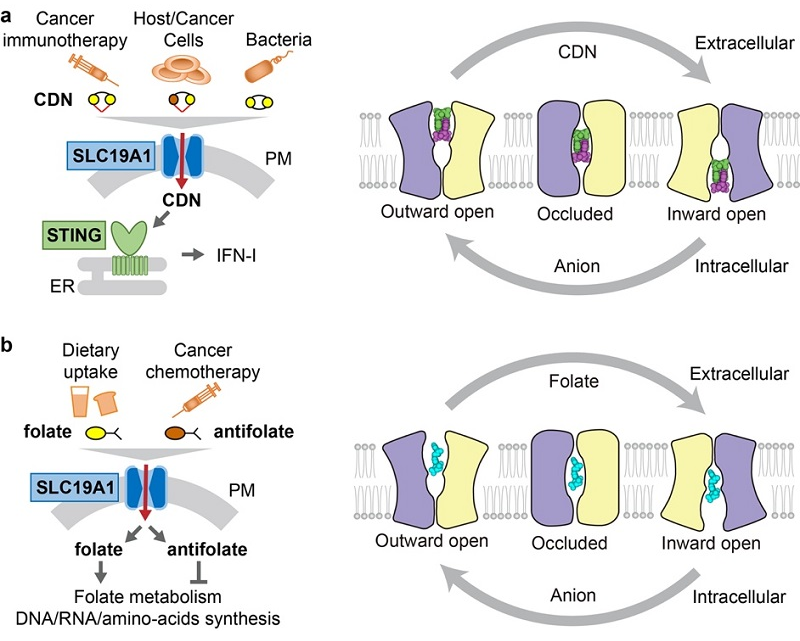Researchers Uncover Recognition Mechanisms of Cyclic Dinucleotides and Folates by Human SLC19A1
Cyclic dinucleotides (CDNs) are ubiquitous signaling molecules in all domains of life. Mammalian cells produce one CDN, 2'3'-cGAMP, by cyclic GMP-AMP synthase upon detecting cytosolic DNA signals. 2'3'-cGAMP produced by mammalian cells, as well as bacterial and synthetic CDN analogs, can act as second messengers to activate the adaptor protein STING and elicit broad downstream immune responses.
Extracellular CDNs must traverse the cell membrane to activate STING, a process that is critically dependent on the solute carrier SLC19A1. In addition, SLC19A1 represents the major transporter for folate nutrients and antifolate therapeutics, thereby placing SLC19A1 as a key factor in multiple physiological and pathological processes.
However, how SLC19A1 recognizes and transports CDNs and folate/antifolate is unknown. In a study published in Nature, a team led by Prof. GAO Pu and Prof. ZHANG Liguo from the Institute of Biophysics of the Chinese Academy of Sciences and Prof. GAO Ang from Beijing Institute of Technology elucidated the molecular mechanisms of SLC19A1-mediated recognition and transport of CDNs, folate, and antifolate.
By using an antibody-assistant strategy, the researchers in this study determined a series of high-resolution cryo-electron microscopy structures of human SLC19A1 (hSLC19A1) in a substrate-free state and in complexes with multiple CDNs from different sources, a predominant natural folate, and a new-generation antifolate drug.
Structural and mutagenesis results demonstrate that hSLC19A1 utilizes unique yet divergent mechanisms to recognize CDN- and folate-type substrates. Two CDN molecules bind within the hSLC19A1 cavity as a compact dual-molecule unit, while folate or antifolate binds as a monomer and occupies a distinct pocket of the cavity. Despite occupying distinct pockets in current inward-open conformations, CDNs and folate/antifolate still use the same substrate channel for transport and thus will unsurprisingly compete with each other in cellular uptake processes.
Moreover, the structures allow accurate mapping and potential mechanistic interpretation of loss-of-activity and disease-related mutations of hSLC19A1.
This study provides a framework for understanding the mechanism of SLC19 family transporters and serves as a foundation for the development of potential therapeutics.

Schematic representation of SLC19A1-mediated transport of CDNs and folate/antifolate
Article link: https://doi.org/10.1038/s41586-022-05452-z
Contact: GAO Pu
Institute of Biophysics, Chinese Academy of Sciences
Beijing 100101, China
Email: gaopu@ibp.ac.cn
(Reported by Dr. GAO Pu's group)

